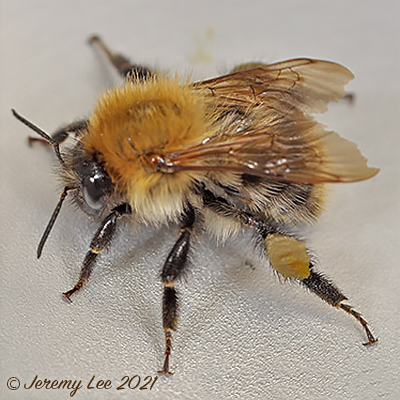
 |
|
Scientific Classifications explained » Amphibians » Ants » Aphids » Bees » Beetles » Birds » Bugs » Butterflies » Caterpillars » Damselflies » Dragonflies » Earwigs » Flies » Frog/Leafhoppers » Fungi » Galls » Grasshoppers » Harvestmen » Hoverflies » Lacewings » Ladybirds » Leaf Mines » Lichens » Mammals » Millipedes » Mosses » Moths » Sawflies » Slugs » Snails » Spiders » Trees & Shrubs » Wasps » Wild Flowers » Woodlice » Postboxes |
UK Nature > Bees > Bombus pascuorum

Scientific Name: Bombus pascuorum Common Name: Common Carder Bee Bombus pascuorum, or the Common Carder Bee as it's more commonly known, is usually up to 18mm in length; the thorax is usually reddish brown (the only garden bumble bee with this colour), although very dark in northern areas. The abdomen has a rather thin coating of brown, black or grey hairs. Visits a wide range of wild and cultivated flowers, and is especially fond of lavender. Nests are usually built in long grass at ground level, but this species also builds in old birds' nests well above ground and even takes up residence in bird boxes. Queens usually appear late March or April and the colonies continue well into the autumn, long after most other bumble bees have disappeared. Found in most habitats, it is a very common garden species in the UK but uncommon in more exposed areas. |
|

https://www.uknature.co.uk is a website dedicated to showing the immense diversity of UK nature and wildlife. Our vast range of habitats, from lowland arable to snow covered mountains, from storm-ravaged coastlines to peaceful inland freshwater lakes and rivers, from dry, sandy heaths to deciduous and coniferous forests, all these habitats contribute to the abundance of UK nature. We have wild birds in huge numbers either residing or visiting our shores (597 recorded species as at July 2013) and we must also not forget the humble back garden with its grass lawns, flower beds filled with nectar rich flowers, shrubs and trees, all designed to attract huge numbers of insects such as bees, moths, butterflies and hoverflies; and finally the small ponds which provide safe havens for frogs, toads, newts and even slow worms and grass snakes. www.uknature.co.uk is the showcase for my personal passion, photographing uknature in all its glory. I sincerely hope you all enjoy the fruits of my labours. This site and all images contained therein is © Jeremy Lee 2004 - 2025. All Rights Reserved. Site design by Jeremy Lee. Site development & IT Support by Stuart Lee. |